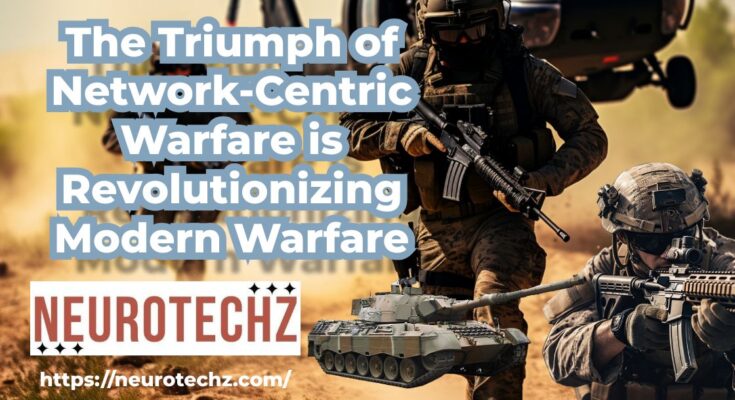Network-Centric Warfare, modern warfare technology, alters military strategies worldwide
The techniques and tactics used by the military worldwide are constantly changing due to technical developments in modern Warfare. Of all these revolutionary developments, Network-Centric Warfare (NCW) is particularly noteworthy because it represents a paradigm change in the way the armed forces conduct their operations, exchange information, and accomplish their goals. The notion of network-centric Warfare, along with its applications, tenets, and effects on modern military operations, are carefully examined in this article.
Understanding Network-Centric Warfare
Enhanced situational awareness, decision-making, and overall combat effectiveness can be achieved through integrating information networks, modern communications technologies, and real-time data analysis, according to the military doctrine known as “Network-Centric Warfare.” Fundamentally, NCW aims to build an agile and cohesive force that can take coordinated action and respond quickly in conflict by utilizing interconnected networks’ power.
Principles of Network-Centric Warfare
The concept of Network-Centric Warfare is based on several fundamental principles.
Information Superiority
To help soldiers and commanders make wise judgements on the battlefield, NCW prioritizes gathering, analyzing, and disseminating timely and reliable information. All actions conducted by NCW are built upon this emphasis on information superiority.
Shared Awareness
All echelons of command and the various military branches are encouraged to exchange information and situational awareness by NCW. NCW allows scattered units to work together and coordinate their operations by giving them a shared operational picture.
Decentralized Execution
Decision-making authority is decentralized to lower echelons of command under NCW, in contrast to traditional command structures, which mostly rely on centralized control. In dynamic combat scenarios, this decentralization allows for greater flexibility, swifter reaction times, and higher agility.
Rapid Feedback Loop
NCW depends on real-time feedback mechanisms to evaluate military operations’ efficacy and modify tactics as necessary. NCW helps forces to keep a competitive advantage over rivals by continuously assessing results and making necessary adjustments to strategy.
Applications of Network-Centric Warfare
There are numerous military actions and fields in which Network-Centric Warfare concepts apply.
Command and Control
NCW gives commanders a complete picture of the battlefield, including the position and condition of both friendly and enemy forces. This improves command and control capabilities. Resources can be allocated, and decisions made more skillfully thanks to this real-time situational knowledge.
Intelligence, Surveillance, and Reconnaissance (ISR)
To gather and deliver valuable intelligence to ground forces, NCW combines various ISR capabilities, including satellites, drones, and reconnaissance planes. NCW facilitates quickly identifying high-value targets and possible threats by fusing sensor data with sophisticated analytics.
Precision Strike
NCW uses networked weapons systems, such as guided missiles and smart bombs, to impact targets precisely and with the most minor collateral damage. This allows for precision strikes. With less risk to infrastructure and population, armed forces can accomplish their goals thanks to this precision.
Logistics and Support
Supply chain optimization, transportation network optimization, and asset tracking and management are how NCW maximizes logistical support. NCW keeps the operating pace going and extends the endurance of deployed units by guaranteeing timely resupply and upkeep.
Impact of Network-Centric Warfare
Modern Warfare has changed significantly since Network-Centric Warfare was implemented.
Increased Operational Effectiveness
With higher operational effectiveness and mission success rates, NCW allows military personnel to operate with increased speed, precision, and efficiency. NCW increases the lethality and survivability of armed forces in all realms of conflict by utilizing information networks and cutting-edge technologies.
Enhanced Situational Awareness
Commanders may anticipate opponent movements, recognize new dangers, and seize tactical openings because of NCW’s real-time understanding of the battlefield environment. Thanks to their increased situational awareness, military forces are better equipped to maintain and take the initiative in complex and dynamic operating settings.
Improved Interoperability
Using standardized data formats, communication protocols, and information-sharing procedures, NCW facilitates interoperability across various military branches and coalition partners. Coalition warfare and joint operations can be carried out more successfully when allied forces collaborate and coordinate through interoperability.
Evolution of Doctrine and Strategy
A reassessment of conventional military doctrines and tactics has resulted from adopting network-centric Warfare, and new concepts and tactics suited to the information age have been developed. Fundamental changes are occurring in Warfare as forces continue to adjust to the opportunities and challenges NCW poses.
Challenges and Future Prospects
Although there are many benefits to network-centric Warfare, there are also drawbacks.
Vulnerability to Cyber Threats
Systems used by NCW are vulnerable to cyber threats such as malware, hacking, and electronic Warfare because of their dependence on information networks and digital technology. These networks’ operational security and integrity must be preserved by protecting them against cyberattacks.
Overreliance on Technology
There is a risk of system breakdowns, malfunctions, or disruptions in communications and information systems because Network-Centric Warfare relies too heavily on technology. Military forces must weigh the advantages of technological progress to maintain redundancy, robustness, and fallback processes.

Adaptation of Adversaries
The proliferation of NCW capabilities may lead opponents to create countermeasures and strategies to exploit networked systems’ weaknesses. Continuous learning, experimentation, and adaptation are critical in modern combat because of the conflict between hostile adaptation and technical innovation.
Anticipating further developments in artificial intelligence, autonomous systems, quantum computing, and other cutting-edge technologies, Network-Centric Warfare’s future is expected to be firmly established. Military forces can continue harnessing the power of Network-Centric Warfare to accomplish their strategic objectives in an increasingly complex and contested security environment by staying at the forefront of technological innovation and proactive in doctrine development and training.
Knowledge of Data-Centric Definition
A concept that emphasizes data as the centre of all activities—including analysis, creativity, and decision-making—is fundamentally data-centric. Data is the fundamental asset in a data-centric strategy, as opposed to traditional techniques that see data as only a byproduct or support aspect. This change in viewpoint sparked An enormous transformation in how organizations view, manage, and use data.
Fundamental Components of Data-Centric Definition
Data Accessibility and Availability
Ensuring data availability and easy access for pertinent parties is emphasized in a data-centric definition. This implements a robust data infrastructure—such as cloud-based repositories, lakes, or data warehouses—to store and handle data effectively. Insight extraction in real-time is enabled by accessibility, which also makes data-driven decision-making more fluid.
Data Quality and Integrity
High standards of data integrity and quality are essential to the data-centric strategy. Data cleansing, normalization, and validation are other procedures to reduce dataset mistakes and inconsistencies. Organizations can improve the dependability and credibility of their analyses and results by maintaining data quality.
Data Governance and Compliance
Data-centricity calls for solid governance structures to control data consumption, privacy, and security. The ethical management of data is ensured, and stakeholder trust is fostered by compliance with regulatory regulations such as GDPR, HIPAA, or CCPA. Additionally, transparent data governance guidelines reduce the risks of data breaches and misuse while streamlining data management procedures.
Data Integration and Interoperability
Integration and interoperability are critical to fully utilizing the potential of diverse datasets in a Network-Centric Warfare paradigm. Organizations can find undiscovered correlations and gain comprehensive insights by harmonizing data from many sources and formats. Additionally, integration allows for smooth data flow between various platforms and systems and promotes cross-functional cooperation.
Applications of Data-Centric Definition
Business Intelligence and Analytics
Applying a Network-Centric Warfare strategy in business intelligence transforms decision-making by offering practical insights from thorough data analysis. By utilizing data-centric definitions, organizations can benefit from a competitive edge in the market and drive strategic objectives, including risk assessment, operational efficiency, consumer behaviour and market trends.
Healthcare and Life Sciences
A data-centric approach to thinking can revolutionize patient care, medication development, and illness management in the life sciences and healthcare. Healthcare providers can anticipate the course of diseases, tailor therapies, and improve patient care by gathering and evaluating patient data. Comparably, Network-Centric Warfare methods in pharmaceutical research speed up drug development pipelines and enable efforts related to precision medicine.
Smart Cities and Urban Planning
Intelligent cities optimize urban infrastructure, increase sustainability, and improve the quality of life for inhabitants by mainly relying on data-centric definitions. City planners can efficiently control traffic flow, energy consumption, and environmental concerns using IoT sensors, geospatial data, and real-time analytics. When solving complicated urban problems, Network-Centric Warfare urban planning encourages creativity and adaptability.
Scientific Research and Exploration
Research definitions centred around data drive advances in various fields, including particle physics, climate science, astronomy, and genomics. Researchers can solve complicated problems, support theories, and advance human understanding by analyzing enormous datasets produced by simulations, experiments, and observations. Scientific advancement and interdisciplinary cooperation are accelerated by data-centricity.

Implications and Future Directions
Organizational perspectives on the use of data assets are changing, as seen by the rise in data-centric definitions. The necessity for qualified data professionals, ethical considerations, and data privacy issues are a few of the many difficulties and issues this transition raises. The realization of data-driven innovation and decision-making’s full potential in the future will depend critically on resolving these issues and promoting a data-centric culture.
Origins of Warfare Gaming
Ancient military leaders used strategic board games to sharpen their talents, which is where the origins of warfare gaming may be found. Go is a well-known game example where players must predict their opponent’s moves and maintain territory. It is thought to have originated in China around 2,500 years ago. Like chess, which originated in India, it became well-liked throughout Europe and the Middle East as a military and noble training tool.
The Rise of Tactical Board Games
The intricacy and sophistication of wargaming increased along with society. Board games such as Kriegsspiel were essential to military instruction and training in the 19th and 20th centuries. Officers could practise making strategic decisions in a controlled setting with Kriegsspiel, a game developed by the Prussian army in the early 19th century that used maps, miniatures, and rulesets to replicate battlefield scenarios. Modern wargaming techniques were founded on this concept, which had an impact on military colleges across the globe.
Technological Advancements and Digital Revolution
With the introduction of computers, a new era of realism, complexity, and scalability was brought about in battlefield gaming. Computerized simulations of several facets of Warfare, ranging from tactical encounters to geopolitical wars, were developed by academic institutions and defence organizations in the mid-1900s. With the unparalleled fidelity these simulations provided, analysts were able to examine a plethora of scenarios and more accurately evaluate the possible results of military strategies.
From Command & Conquer to Virtual Battlefields
Battleground gaming became popular in the entertainment business when gaming consoles and personal computers were more widely available in the latter half of the 20th century. With their unique blend of strategic depth, immersive gameplay, and historical realism, video games such as “Command & Conquer,” “Total War,” and “Civilization” attracted fans. Players learned the essentials of military strategy, logistics, and diplomacy while immersing themselves in hours of amusement from these games.
Serious Games and Military Training
Warfare games are used for more than just pleasure; they are also for operational planning, professional growth, and military training. To train people in a variety of scenarios, from counterinsurgency operations to humanitarian assistance missions, defence agencies worldwide employ advanced simulations and virtual environments. With a low danger and resource expenditure, these severe games provide a safe and economical means of preparing soldiers for the intricacies of contemporary combat.
The Role of Artificial Intelligence
Warfare gaming has seen a paradigm shift thanks to artificial intelligence (AI), which has made simulations more dynamic and lifelike than in the past. AI-powered opponents can change their tactics, pick up lessons from previous games, and pose challenges to players that resemble real-world opponents. In addition, artificial intelligence (AI) systems can help military planners make better decisions at all command levels by analyzing enormous data analyses, spotting trends, and forecasting possibilities with previously unheard-of precision.
Ethical and Legal Considerations
There are significant ethical and legal concerns about how violence is shown, how enemy combatants are portrayed, and whether or not players may get desensitized to the horrors of war as military gaming becomes more realistic and immersive. In addition, questions concerning responsibility, civilian casualties, and the decline of human judgement and empathy in combat are brought up by the employment of game technology in military operations like drone warfare and autonomous weaponry systems.
Future Trends and Innovations
As artificial intelligence, technology, and human-computer connection progress, military gaming is expected to grow. Virtual reality (VR) and augmented reality (AR) can produce even more immersive and dynamic training environments, enabling soldiers to practise missions in incredibly lifelike simulations before encountering real-world obstacles. Warfare games will also be able to forecast new threats, modify their tactics in real-time, and develop more adaptable and durable armed units thanks to machine learning algorithms and predictive analytics.
Summary
Network-centric Warfare offers a revolutionary strategy for combat that improves military agility and effectiveness by combining information networks, cutting-edge technology, and decentralized decision-making. Militarism may become more successful on the battlefield and adapt to the changing challenges of the information age by adopting the NCW principles and investing in developing robust and resilient networked capabilities. In the twenty-first century, network-centric Warfare will continue to be a mainstay of military doctrine and strategy due to the rapid advancement of technology and the ever-changing nature of battle.




